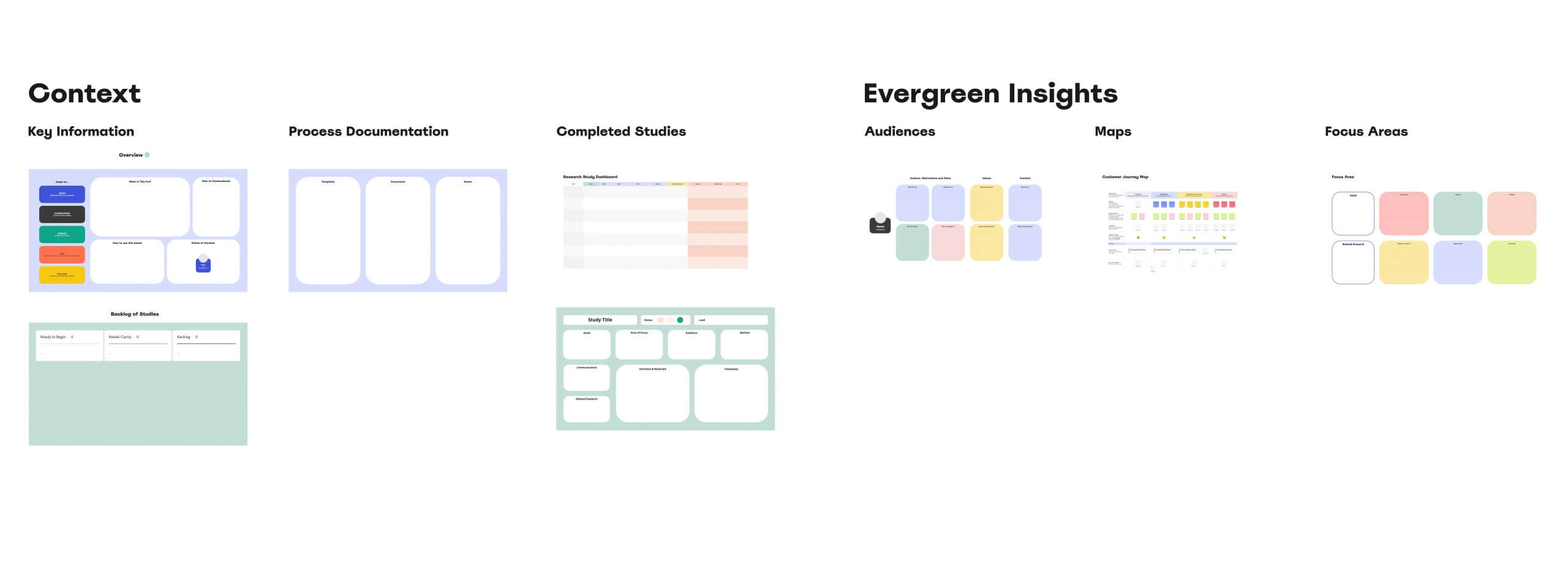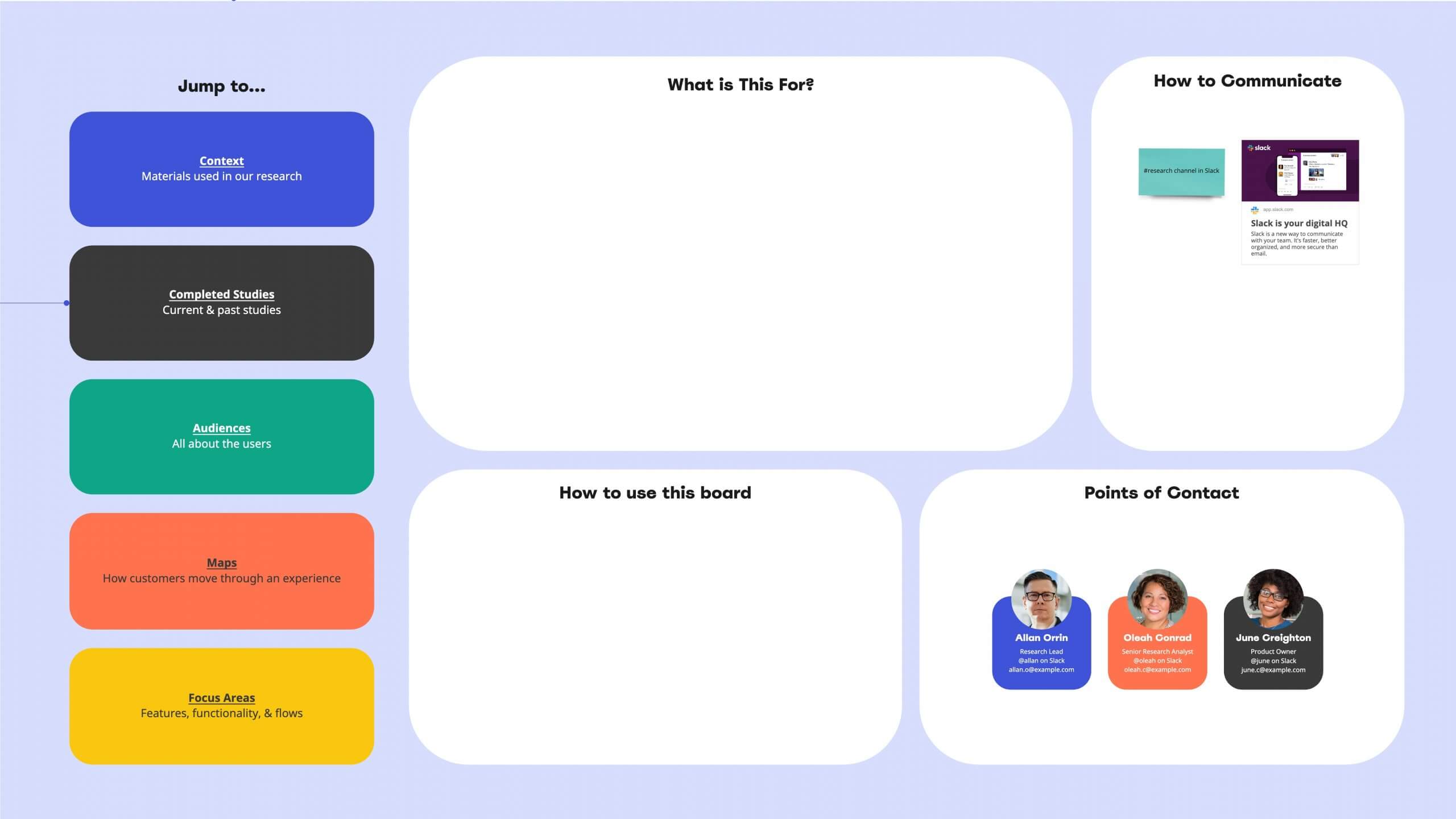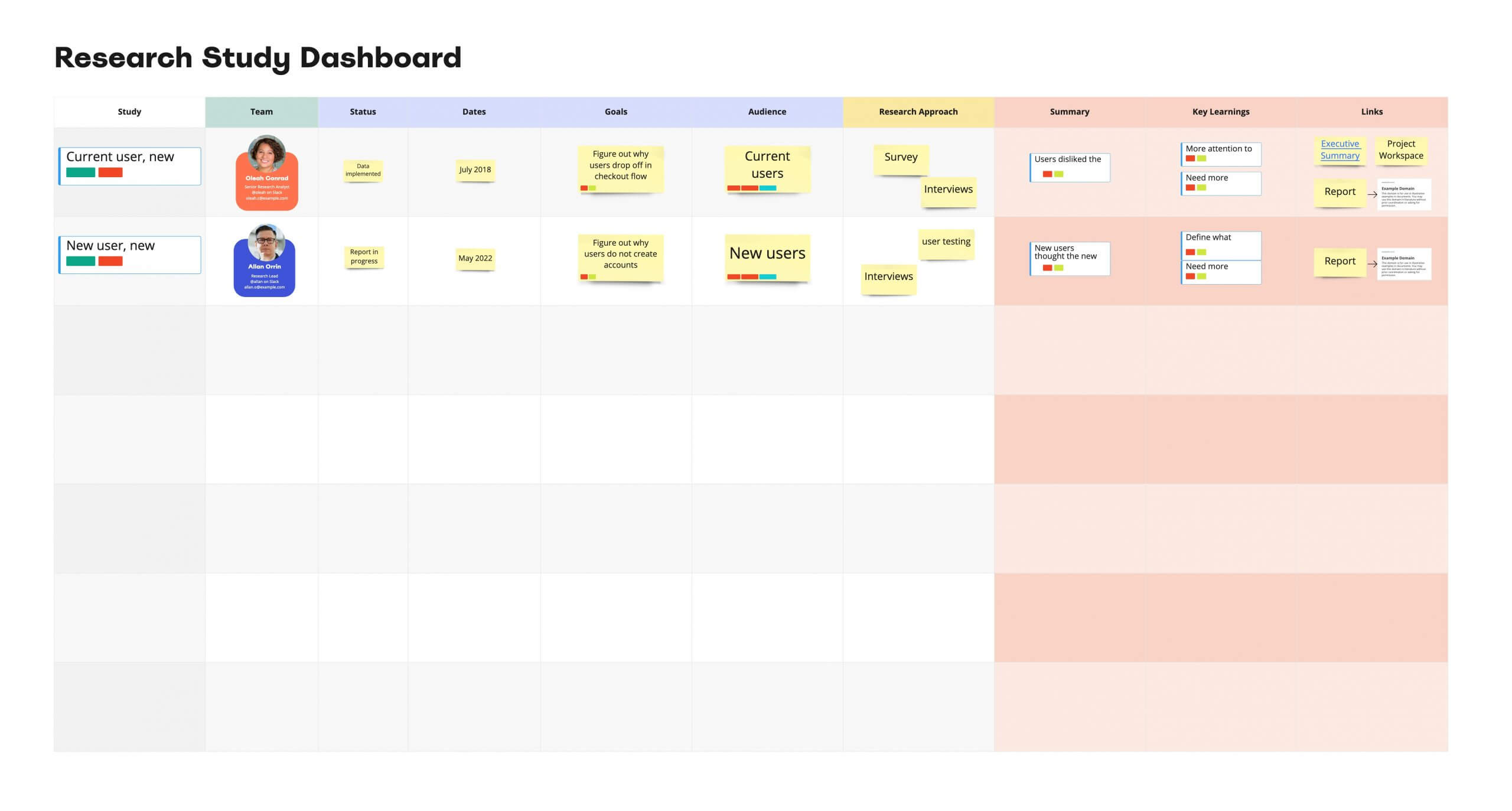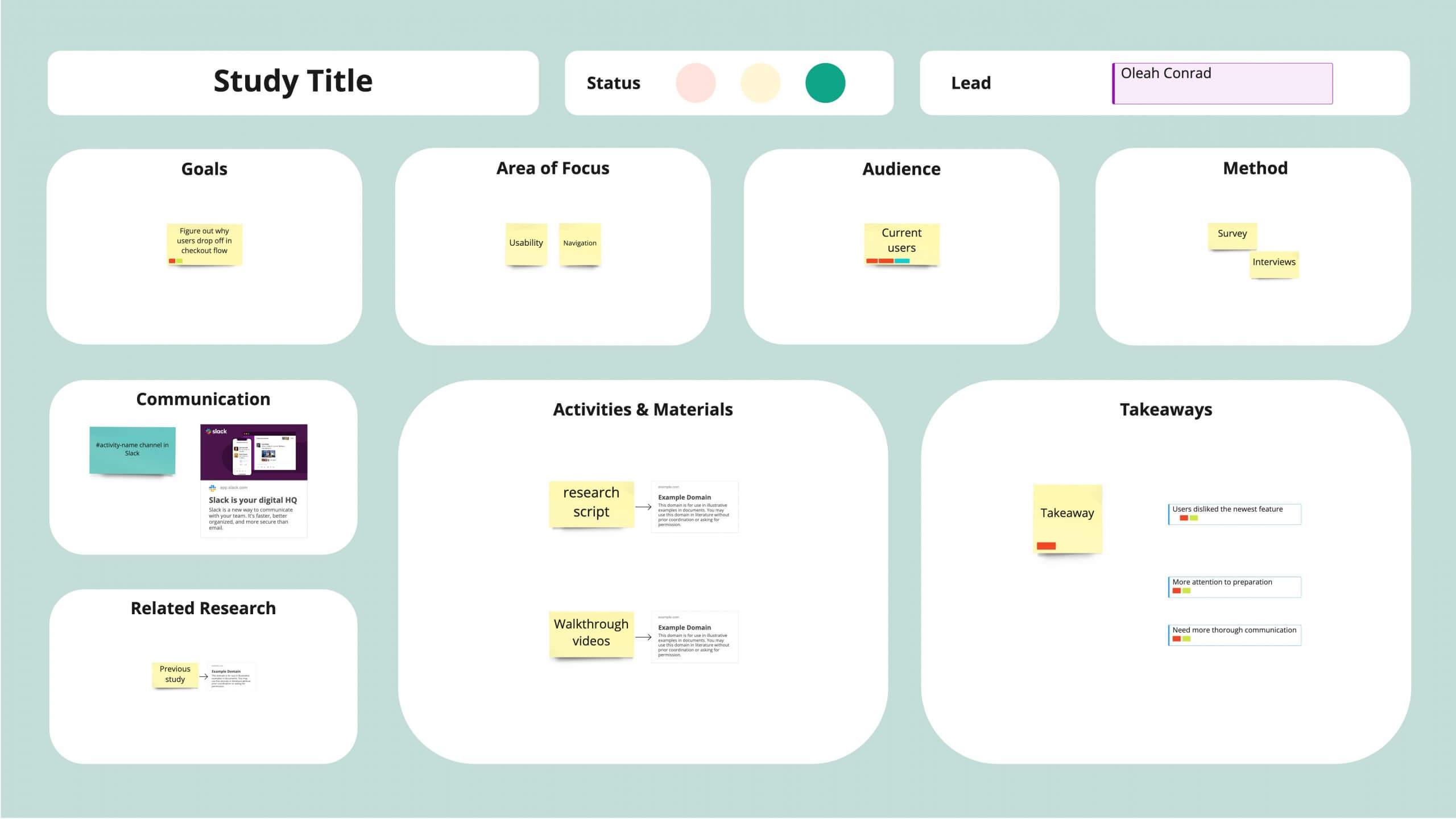UX Research gained a central role in organizations over the years as a linchpin of innovation. As UX teams grow, the challenge now is to have a unified UX research front, where knowledge is accessible, people understand research insights, and have the necessary tools to innovate and improve their products. We present to you a new UX Research Repository Template and how Miro serves as a database for so many UX teams.
As a content professional, I’ve personally benefited from UX research findings. They’ve helped me become a better writer, design better website experiences, and connect the right information and people with the right time and place.
While managing our templates content production, I was lucky to work with Shipra Kayan, a leading product evangelist and seasoned UX designer and facilitator. She ideated and created our newly published UX Research Repository Template.
I’m happy to report that we now have a UX Research Repository Template in Miro.
In this article, you’ll find Shipra’s insights on UX repositories, how to use the template, why it’s important, and how to advocate for a better, more organized UX research practices inside your organization.
Empathy is the way in and out
We’re committed to bringing you the best experience: When you’re using our product, levering our content, and getting to know our platform. To achieve this, we at Miro live by these company values:
- Play as a team to win the world
- Practice empathy to gain insight
- Focus on impact and make it happen
- Learn, grow, and drive change
As you can see, empathy is one of our core values, and it helps us practice all the other values. We can only improve our platform when you give us feedback. Yes, I’m talking to you, our beloved Miro user.
As a content writer, user research helps me craft and produce the best content for our users. Our UX Research Team grew exponentially in the last couple of years, enabling us to attend to other teams’ needs and democratize user research so anyone at Miro can access it. By design, we are a customer-driven organization.
As we embrace innovative ideas and help others transform their work, our team’s fell into the same old organizational trap: We have too many documents for each project. After creating numerous research boards and sharing them at Miro’s Voice of the Customer All Hands — an internal cross-functional meeting where we highlight the main insights and learnings from our customers and how to turn them into insights — we concluded that a UX Research Repository is mandatory. And we feel that we should share that with you, too.
I had the chance to participate in this process closely, which gave me the idea to write this article. I also must thank another Miro UX researcher, Andrej Balaz, who showed me how a feedback session works and how to validate assumptions and improve designs. Crema, our partner agency on this project, also remarkably brought in their empathy and expertise. Thank you all for teaching me from the inside out how a design process works and how a UX research repository can help teams thrive.

On UX Research: Uncover insights and make better-informed decisions
The role of a UX Researcher is to collect and analyze data about customer needs, goals, and behaviors so product managers, designers, and anyone inside the organization can make better decisions. More often than not, research teams work closely with product managers, designers, and engineers to ensure products are useful and used by the target audiences.
As you can see, their role is vital for any organization that wants a customer-centric culture. Through user interviews and research studies, they become the voice of the customer in the organization, bringing invaluable insights to product teams and anyone working on improving user and brand experiences.
When I first joined Miro, I thought user research was something only product managers did. Oh, how wrong I was! And if you still doubt the importance of a UX research team, here are a few things to consider:
- UX Research teams limit organizational silos. They connect the product, engineering, and design teams and help them align strategies company-wide.
- They help leaders connect with audiences, humanize their approach to business, and build better products.
- They spread the word. UX Research teams value empathy and advocate for a better understanding of data and customer behavior throughout the organization.
- Research studies have specific goals closely tied to the project at hand, but they often reveal nuggets of insights applicable beyond the current projects.
These are just a few of the many benefits of having user research inside your organization. Now, let me show you how the UX research repository works.
What’s Miro’s UX Research Repository? A Quick View
A UX Research Repository is a place where research teams can consolidate and gather all the work across teams and projects. It’s a database where anyone inside the organization can look for insights and information to leverage decision-making.

While interacting with research leaders in her peer group, Shipra observed that many research teams used Miro for their research repositories.
“We noticed that many UX teams are using Miro as a research repository. While research repositories have been a hot topic for almost a decade, we still don’t have an agreement on the best method to organize research data. The community has interesting examples and videos showing different approaches to a repository.”
User showcasing how to use Miro as an user research repository.
Shipra identified research teams’ pain points when organizing their research.
“Every research team spends hours fielding this question: “Have we got any data on xxx?”. Research repositories ensure that collective historical knowledge and wisdom are easily mined and reduce work waste.”
“We synthesized some of the best ideas from talking to our customers to create this template. It is a great place to start if you don’t have a repository yet.”
Why is it important to have a well-organized research repository?
Speaking for myself, it’s made my life much easier. The research repository saves time when looking for documentation about customers, user insights from other product streams, and customer requests, so I know what people are missing or looking for when searching for content on our website or product.
My experience, I came to learn, is universal:
Well-organized repositories make it easy for cross-functional stakeholders to help themselves to data and insights without relying on tribal knowledge. Every research team should have one, whether a team of 1 or 100.
Shipra Kayan, Principal Product Evangelist at Miro
According to Shipra, the idea of Miro’s UX Research Repository Template is to serve as a home base for research teams and a space where cross-functional stakeholders and collaborators (like me) can easily search through the board and find relevant nuggets to double-click on.
And research repositories need to be multi-dimensional, searchable, tag-able, visual, and editable, and Miro is the perfect tool to host one.
Miro’s UX Research Repository Template
“We tried to find the balance between structured and free-form content, so we created a template where you can store individual nuggets from studies and tag and organize studies by date, persona, theme, or any other facet that makes sense for you.”
Highly customizable, our UX Research Repository Template allows you to collect different kinds of data in one shared space, including live embeds from your current spreadsheets.
“Along with research studies, research teams have a unique view into universal truths. What insight do you see across multiple studies? We also suggest sharing these “universal truths,” generally in the form of personas, journeys, or jobs to be done on this board as well!”
Of course, research operations in your organization might also need help from other tools and templates. Shipra advises anyone looking into having a more robust research repository to try the following:
“There are some incredible research planning and synthesis templates in Miroverse, and I suggest having one board for each study. The research repository will link out to these individual study boards.”

The secret to a successful UX research hub? Get everyone on board, including non-design folks
As I learned, many teams end up working in silos, which is one of the main problems when leading UX research efforts in organizations.
When I asked Shipra about how to optimize collaboration and include non-design folks in the process, she offered these tips:
- Pin the UX research repository right on top if you have an #ask-research Slack or Microsoft Teams channel.
- Use Sack bots creatively to automatically reply with “did you check the repository?”.
- Create a team norm. Whenever anyone asks you, “Do we have data on…,” point them to the repository instead of the actual study.
- The best way to ensure your repository is useful and usable is to do some user testing. Are you capturing the right level of information, and do they understand how to get more information on any particular study?
- Ensure that you are not using jargon in your repository (e.g., instead of saying “mixed methods,” you might want to say “survey and interview”).
Tips from Shipra Kayan: How to maximize your UX research repository
Now that you have access to the UX Research Repository Template, here are a few things you can do to maximize your research team efforts:
Focus: Research Study Dashboard

This will be the most used area of your repository:
- Tags can be really powerful when used systematically. Agree on a set of common tags as a team. Then tag every study and insight that you put on the board. Don’t create new tags without normalizing with the existing set.
- Ensure that this information is always up to date. Use the first 10 minutes of your research team meeting (weekly or monthly) to update the repository.
- Highlight 3 key insights for each study right on this research repository board. Add those insights that you think will be relevant across product areas and far into the future. They may not be the same as the most important insights you share with your current project team, so what about this study should the rest of the organization know?
- Consider which research studies don’t need to be added to this table. It’s best to keep discovery and generative studies on this board, but if you try to add every evaluative study or user testing session, that can get unwieldy. Pro tip: Put it on the board if you can imagine this data being relevant even a year from now.

If you want to know more about UX research, we have an excellent guide by Josh Zak, the founding partner at Turtle Design.




